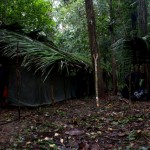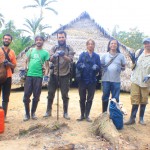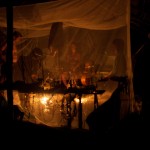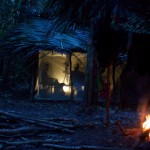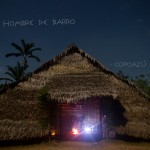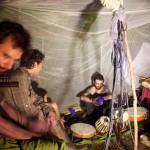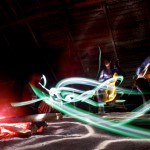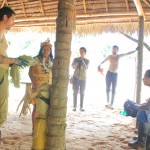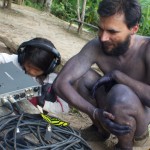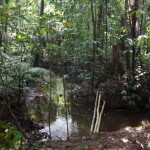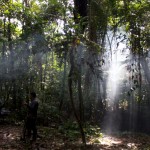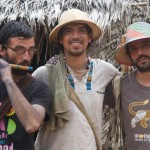Hombre de Barro. Copoazú
- Music
Rivers are a collection of countless little streams. Each stream originating from a different source. Sources that can come from bubbling underground springs hidden in distant forests, waterfalls pouring down from ancient glaciers under the high misty peaks.
No matter their source, each stream tells their story. Rolling into other streams, uniting their tales, they eventually become a grand river of song.
Hombre de Barro is the uniting of three musical rivers.
Each river having explored different sources all around one of the most culturally and ecologically diverse countries of the world. Colombia.
When these rivers unite, they travel as one. Together, they create new pathways into unexplored lands by sharing the songs and tales of all the sources where the true music is from.
Teto Ocampo -- guitar and flutes
Urian Sarmiento -- percussion and flutes
Juan Manuel Toro -- cello
- Space
By request of the musicians, these recordings took place in the Colombian Amazon rainforest. In collaboration with the Foundation Raices Vivas, that works in the area in and around Puerto Nariño.
Puerto Nariño is located in the Amazonian Trapezium. The area of the Amazon that is shared by Colombia, Brazil and Peru. It is the home of three indigenous cultures, the Ticuna, Yagua and Cocama. All of which are currently under harsh cultural pressures due to outsider colonization of their territory.
The recordings took place in two locations. One was a Maloca, a traditional Amazonian longhouse, 45 minutes hike into the forest from Puerto Nariño.
The other location was a meeting of two small rivers an hour hike deeper into the forest from the Maloca. Here we set up an impromptu lean-to for the hammocks of the entire crew and the mosquito net for the deep jungle recording studio.
The Amazon rainforest is a very intense environment in normal circumstances. Trying to record an album there with solar power was quite an adventure that pushed all of us to our limits. Each of these tracks has a story linked with them that helps better understand the environment in which this music was created.
1) La llamada (the calling)
On the second night at the deep jungle studio, our two guides left us to solve some pressing situation with a local leader. At night, we realized that those of us left at the camp had no idea how to get back to the village if anything were to happen. Crawling through the dark jungle aimlessly would not have been an option.
So, all 9 of us climbed into the mosquito net studio designed for 4 people and hid from the tremendous mosquito onslaught going on outside. The music played that evening was a musical conversation with the jungle. Calling out to the infinite voices hiding in the dark that sang and breathed all around us.
Later, in our hammocks, busy killing the mosquitoes keeping us from sleep, we heard a sound. A sound that silenced us all. The tension turned to laughter as we were more concerned with killing the mosquitoes than the growling sound just outside camp.
The next day we found out from our guides that it was a Jaguar.
2) Habitante Rojo
After the first night at the deep jungle camp where we had a late night termite invasion, it took most of the next morning to set up the studio. Building benches in the mud for the musicians and engineer to sit on, setting up the mics, cables, tuning the instruments, etc.
During this process I think we all realized how crazy this was.
Later in the day, the band played this track and we then realized something special was about to happen out there.
3) Caminando a la Maloca (walking to the Maloca)
To get to Puerto Nariño you have to ride upriver on the Amazon for a few hours from Leticia. After doing this, we grabbed all our gear and hiked for 45 minutes through the forest. The sounds on this track are what we heard as we arrived at traditional longhouse, the Maloca. It was an arrival ceremony being offered to us by the Ticuna family that would be hosting us during our stay there.
4) Selvaluz
The jungle dawn has a strange wondrous light. The sun rays that make it through the countless layers of vegetation cascade down as golden beams.
This was the first piece of music played on the first morning of recording at the deep jungle studio. Our first musical offering to the forest.
5) Canto Ticuna de Doña Alba (Traditional Ticuna song from Doña Alba)
One afternoon at the Maloca, our host, the Ticuna elder, Doña Alba, offered an entire ceremony of story and song to the sacred jungle fruit, the Chontaduro. When ripe it is peeled, mashed and turned into a juice that has many medicinal properties.
6) Bimforro
While recording in the Maloca, at night the full moon would slowly come up over the jungle horizon and illuminate the green darkness all around us.
This was the last song played on the last night of our time in the jungle.
7) Por Dios Mayo
In the jungle, the rain comes and goes like waves. Not being able to see the horizon, you are not very forewarned of the storms arriving. One second it is blazing sunlight, the next pouring rain, and many times, both at the same time.
This song was played just hanging out with the family in the lean-to kitchen near the Maloca waiting for lunch in the rain.
8) Muerte y ascensión de un arbol (death and ascension of a tree)
At the Maloca, on our last day of recording, right when we were ready to go, the sound of a big chainsaw invaded the area. We soon found out some neighbors were cutting down a massive old tree. Our hosts were very upset as they knew which tree it was and couldnt believe it was being cut down. It was hot, the air was tense. The sawing sound was deep and constant.
Out of nowhere, this music came from within the Maloca, flying out into a jungle that faces destruction at the hand of men and their machines.
- Earth
These recordings were done in collaboration with the Raices Vivas Foundation. A project that works with the indigenous communities in the area of the Amazonian trapezoid.
Raices Vivas was an idea born from the elders of the area to try to stop the cultural and ecological devastation going on in the area. The idea was to bring artists from around the world to the jungle to share with the local artists and children. In hopes that through the process of sharing we can all learn to respect what each culture has to share. Remembering through art, that we are all children of the earth. And that we need to care for her and learn from the cultures that have been living in contact with her for as long as anyone can remember.

